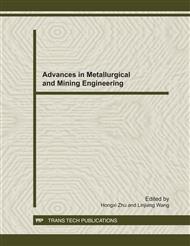p.57
p.61
p.66
p.74
p.78
p.85
p.90
p.96
p.100
Detection of Carbon in Ferroalloy Using Internal Standard Method Based on LIBS
Abstract:
Using LIBS (laser-induced-breakdown-spectroscopy)technology, element percent in ferroalloy can be measured. High energy laser beam focus on high temperature plasma of ferroalloy surface, using fiber spectrometer detected plasma emission spectral lines in the cooling process to determine the type and content in the ferroalloy elements. In the application of quantitative analysis internal standard method in ferroalloy C content, according to the measuring principle built experimental platform, according to Fe for internal standard elements, setting up the calibration curve of C content, and using the curves to ferroalloy samples in a quantitative analysis on the C element. The results show, LIBS internal standard method to determine the relative error of the ferroalloy C content for no more than 10%, verifying the internal standard method used in the determination of the elements in ferroalloy feasibility.
Info:
Periodical:
Pages:
78-81
Citation:
Online since:
November 2011
Authors:
Price:
Сopyright:
© 2012 Trans Tech Publications Ltd. All Rights Reserved
Share:
Citation:


